Top>Research>Educational experiment for school trips using smartphones
 Index
Index
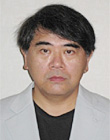
Fumihiro Sato [profile]
Education Course
Educational experiment for school trips using smartphones
Fumihiro Sato
Professor of Information Technology, Faculty of Economics, Chuo University
1. Research group
Recently, the Asahi Shimbun Newspaper (Sept. 29, 2012, Tokyo edition) reported on an experiment for a learning application for school trips using smartphones. This experiment was based on the know-how which has been accumulated by the "Happy School Trip Research Group". Firstly, I will discuss the background of experimental research conducted by this research group.
More than three decades have passed since the term "information society" has come into use. However, the quality of information is diverse and there is a great risk in the use of information by children. And the current issue in school education is how to control the use of information. At the same time, when today's children are grown up, society will require them to be able of use information skillfully instead of being thrown around by it. In order to conduct specific and effective initial education for cultivating such ability in children, the role of information education including information ethics is expected to grow in future.
The research group was founded in 2006 with the objective of studying practical approaches for school trips (field trips) as part of this information education. Specifically, the group wanted to position such trips as an opportunity for children to actually associate with society. Members of the group come from a wide variety of industries and fields from; schools and travel agencies who actually plan the school trips, municipalities and tourist associations where the trips are destined, communications business and publishing companies who structure the educational content, to contents production companies.
The group is overseen by a study group in the Faculty of Economics, Chuo University. The role of universities is not only to pursue academics, but also to contribute in disseminating the research results in our society. Maintaining the university's public role and neutrality makes it possible to form partnerships between different industries and competitor companies in order to aggregate knowledge and technology in pursuit of a common objective. By using the word "happy" which is not normally appropriate for research activities, it aims to include practical activities of interest to children, where research presentations is not an end.
2. Related research
In addition to focusing on technology and devices based on the keyword of ICT, the group also conducts activities based on the importance of information logistics and information processing between regions. The group operates through two sub-committees; the M-Learning Sub-Committee which currently mainly researches information education and creating useful applications related to it, and the Residence Stay Sub-Committee (min-paku), which cooperates with local organizations to search for private residences which will accept lodgers and serve as an actual base for interaction.
The current demonstrative experiment in Sumida Ward was conducted by the M-Learning Sub-Committee. In addition to the application for junior high school and high school students, from 2009 the sub-committee has been cooperating with Kamiichibukata Elementary School in Hachioji City to conduct a joint research for the utilization of mobile phones in elementary schools. Since 2009, these research results have been presented at the Information Communication Conference, the CIEC Conference and the IADIS e-learning Conference.
Members of the Residence Stay Sub-Committee are from organizations such as the Ie Village Tourism Association in Okinawa Prefecture, Saga Prefecture Metropolitan Management Headquarters, and Noshiro City in Akita Prefecture. In 2008, the sub-committee participated in a public project of the MAFF (Ministry of Agriculture, Forestry and Fisheries). Also, with support from the Remote Island Development Fund of the Okinawa Industry Promotion Public Corporation, the sub-committee has worked compiled a safety standard manual for residence stays.
3. Current experiment
(1) Current conditions and issues for tourism in the experiment region (Sumida Ward, Tokyo)
During the two months since its opening, Tokyo Sky Tree has attracted more than 1 million visitors with more visitors expected in the future. However, an issue for Sumida Ward is to ensure that tourists spend a long time in the area surrounding Tokyo Sky Tree. To resolve this issue, the Sumida Ward Tourist Association is playing a leading role in developing new tourism by; creating a local brand, compiling a walking guide of Sumida Ward with tourist information and its database, together with navigation and automatic translation applications using mobile terminals.
Moreover, following last year's Great East Japan Earthquake of March 11, the number of cancellations due to cancellation of school trips was estimated to be 150,000 people (Nihon Keizai Shimbun Newspaper; May 25, 2011). It is expected that this year students on school trips will be returning to Tokyo, but the importance of consideration for safety and security issues has become greater than ever, including positional information, enabling immediate contact, and securing evacuation areas.
(2) Review conducted by the research group
There is a gap between the conventional paper-based learning conducted before and after school trips, and the on-site learning during school trips. Hitherto, little of the materials which have been thoroughly checked in advance have been utilized on-site.
The M-Learning Sub-Committee seeks to use ICT to associate students with local people, as well as to realize school trips which fully utilize advance learning. As a part of these efforts, the sub-committee created an orienteering application (Suta-Suta Eye) which students use to tour the region by following a quiz made by students during advance learning (refer to the example below). Students divide into groups for an approximately 2-hour walking tour of the region. From 2007, demonstrative experiments were conducted in Fukagawa, Kamakura and Asakusa, and the application was praised for its attempt to stimulate the student interests. The learning effects, and benefits of GPS function providing the safety and security important to schools and parents have been verified.
Example) Quiz: Do dragons have wings?
Answers 1 Dragons do not have wings.
2 Dragons in western culture have wings, but dragons in Japan do not.
3 Some types of dragons have wings while others do not.
4 All dragons have wings.
Correct Answer:3
Explanation: Types of dragons include flying dragons and water dragons. Some types of dragons have wings while others do not. The dragon at XX Temple has a beautiful set of wings. Let's go and see!
(3) Purpose of recent activities
- ・To vitalize the region around Tokyo Sky Tree using the resources of Sumida Ward.
- ・As a new item for school trips, assess the application which connects advance study, on-site experience, and follow-up study
- ・Provide a lively learning experience for students on school trips
- ・Transmit/receive safety information with students on school trips, schools, and parents
The items listed above are the specific purposes of recent activities. As the first step in achieving the purposes listed above, orienteering activities that incorporate past review were held in September in the area surrounding Tokyo Sky Tree. During these activities, a review was conducted regarding the effectiveness for school trips. Review is also being conducted for expanding these activities to other regions within the Tokyo metropolitan area. The orienteering activities also support foreign language. As a mid-term goal, review is being conducted to apply this system for international exchange in Japan's most prominent tourist areas.
4. Demonstrative experiment
(1) Overview of experiment
- □ Date & Time: Sunday, September 30, 2012; 14:30-16:30
- □ Location: Sumida Ward (area surrounding Tokyo Sky Tree)
- Details: The created application (Suta-Suta Eye) was used by high school students, university students and adults to conduct orienteering activities for approximately 2 hours. Approximately 30 people, the size of one class, participated in the experiment.
Participants divided into 9 groups of 4 people each. They walked around the region competing for the highest rate of correct answers.
Administrator PCs are equipped with safety measure functions such as location-tracking GPS and evacuation area information in the event of disaster.
- □ Overview of implementation procedures
- a. Explanation of procedures
- b. Distribution of smartphones to each group
- c. Open application and log in
- d. Confirm destination → Arrival
- e. Answer quiz
- f. Check explanations
- g. Photographing specified buildings, etc.
- h. Confirm next destination → Arrival (afterwards, repeat steps e. to g.)
- i. Complete activities at all 10 destinations. Check score.
- □ Assessment items for implementation
- ・Usefulness of application
- Operability, usefulness, capacity for learning, safety, enjoyment, understandability, sense of togetherness, elements required for school trips, elements required for general tourism
- ・Appropriateness of course
- Enjoyment, ease of walking, appropriateness of landmarks, assessment of selected landmarks
- ・Elements of school trips: learning effects, relation with advance/follow-up learning, accumulation of data for learning results
- ・Effectiveness of smartphones
- Voice input, ease of viewing maps, etc.
(2) Preparations
- ① Creation of orienteering application
An Android application was created based on the contents of the mobile phone application which was used during past demonstrative experiments. CentOS (5.8), MySQL (5.1.58) and PHP (5.2.17) were used as the embedded system for the server. au's IS05 and MIRACH were used as terminals with the Android version 2.2-2.3. - ② Course selection/creation
The data used was from the Sumida Walking Guide published by the Sumida Ward Tourist Association.
Students from the Sato Seminar of the Chuo University Faculty of Economics performed selection/assessment of the course, screen design, and creation of contents such as quizzes.
(3) Implementation system
- □ Fumihiro Sato Lab, Faculty of Economics, Chuo University: planning, course selection, creation of contents, implementation, assessment, creation of report
- Sumida Ward Tourist Association: Provision of materials/documentation, advice on course selection, PR, support for implementation
- Educational Tour Institute: Advice, PR
- KDDI R&D Laboratories: Lending of smartphones
- Yu Watanabe Lab, Utsunomiya University Graduate School: System construction (support from GCLUE, KDDI R&D Laboratories)
- Kinki Nippon Tourist Co., Ltd: Planning advice, development
- Gakken Holdings Co., Ltd.: Participation and cooperation for experiment
- Shogakukan-Shueisha Productions Co., Ltd.: Cooperation in sub-committee
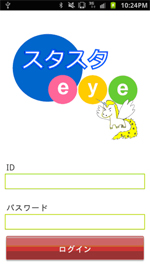
Log-in screen
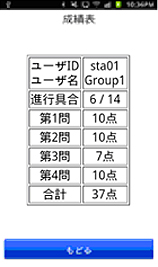
Performance chart
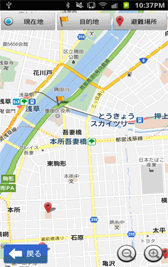
Destination guidance
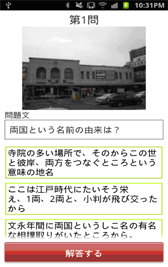
Example question #1
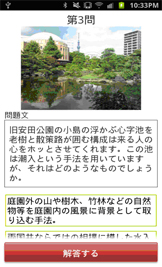
Example question #2
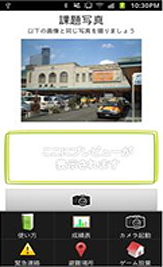
Assigned photography screen
5. Experiment results and future development
1. Implementation results
Weather on the day of the experiment was cloudy and participants were able to visit specified locations with no problem. The breakdown of experiment participants is as follows: 8 students from Chuo University Suginami High School, 20 students from the Chuo University Faculty of Economics, a total of 6 students from Utsunomiya University Graduate School and adults such as research group members, plus 4 staff members.
At the present time, questionnaire results are in the mid-term report stage. 90% of participants gave positive responses for the course selection and questions. However, 26% of participants responded negatively regarding the usability of the application screen. Improvements can be made in areas such as visibility for maps. Even so, responses were overwhelmingly positive for the plan as a whole.
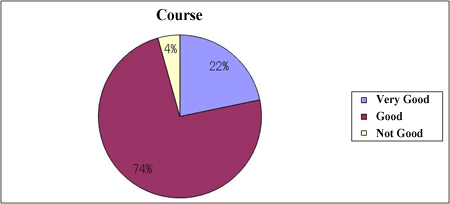
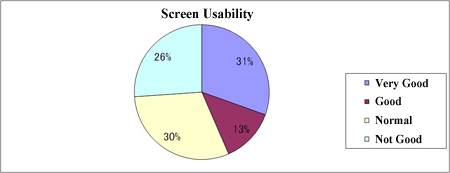
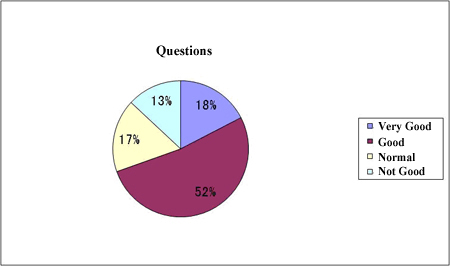
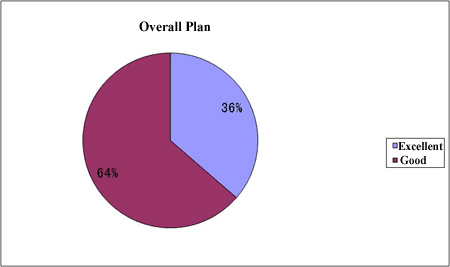
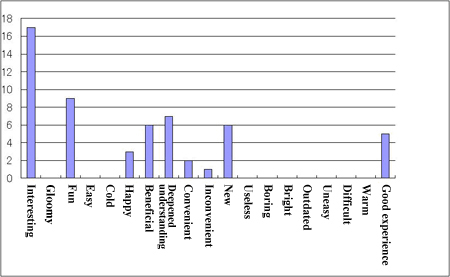
6. Vision for the future
As described above, mostly satisfactory results were achieved from the attempt to utilize ICT during school trips as a method for increasing the learning effect of extracurricular activities. Through this practical research, we can expect future application such as hands-on learning and internships.
Moreover, through the recent experiment, we can further expect the following possibilities.
- ① Discovery of a new way of walking through nostalgic neighborhoods. In particular, fun and education tourism can be created by using smartphones, a device which is widely popular among young people. Nostalgia can be felt as a new sensation by young people and high school students on school trips.
- ② A lineup of school trip contents based on the usefulness of the orienteering application.
- ③ Regarding evacuation areas and other concerns held during tourism since the Great East Japan Earthquake, smartphones enable contents that provide peace of mind without highlighting such issues. In particular, faculty can check the location of all groups on a single screen during group activities. It is also possible to create a function for batch transmission of information, as well as safety measures which use evacuation area information.
- ④ Follow-up use of remaining data as school trip contents: Application to simple usage methods such as use for graduation albums.
In conclusion, I would like to express my deep gratitude to everyone who cooperated in this experiment. Special thanks go to Professor Yu Watanabe of Utsunomiya University, as well as to Guest Professor Yuko Hiramatsu of the Faculty of Economics, Chuo University who constantly worked hard to operate the research group.
- Fumihiro Sato
Professor of Information Technology, Faculty of Economics, Chuo University - Born in Kanagawa Prefecture in 1950.
1974: Graduated from Waseda University (Department of Education)
1974: Entered Japan Information Processing Development Center (assigned to METI's Institute of Industrial Technology in 1981)
1994: Appointed Full-Time Instructor at the Faculty of Economics, Chuo University
1995: Appointed Assistant Professor at the Faculty of Economics, Chuo University
1999: Appointed Professor at the Faculty of Economics, Chuo University
2002-2004: Visiting Researcher at the Center for Design Research, Stanford University
2006-2008: Appointed Vice-Dean, Faculty of Economics
Research themes: e-learning (remote classes), cultivation of ICT professionals in South East Asia
- Research Activities as a Member of Research Fellowship for Young Scientists (DC1), Japan Society for the Promotion of Science (JSPS) Shuma Tsurumi
- Important Factors for Innovation in Payment Services Nobuhiko Sugiura
- Beyond the Concepts of Fellow Citizens and Foreigners— To Achieve SDGs Goal 10 “Reduce Inequality Within and Among Countries” Rika Lee
- Diary of Struggles in Cambodia Fumie Fukuoka
- How Can We Measure Learning Ability?
—Analysis of a Competency Self-Assessment Questionnaire— Yu Saito / Yoko Neha - The Making of the Movie Kirakira Megane








